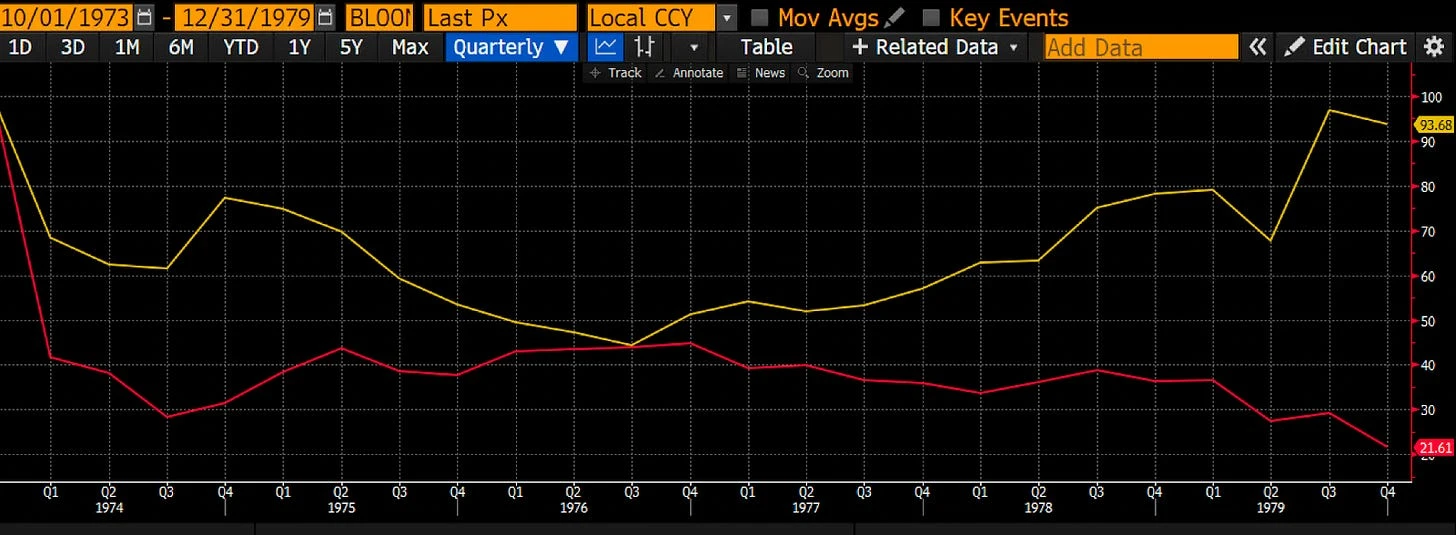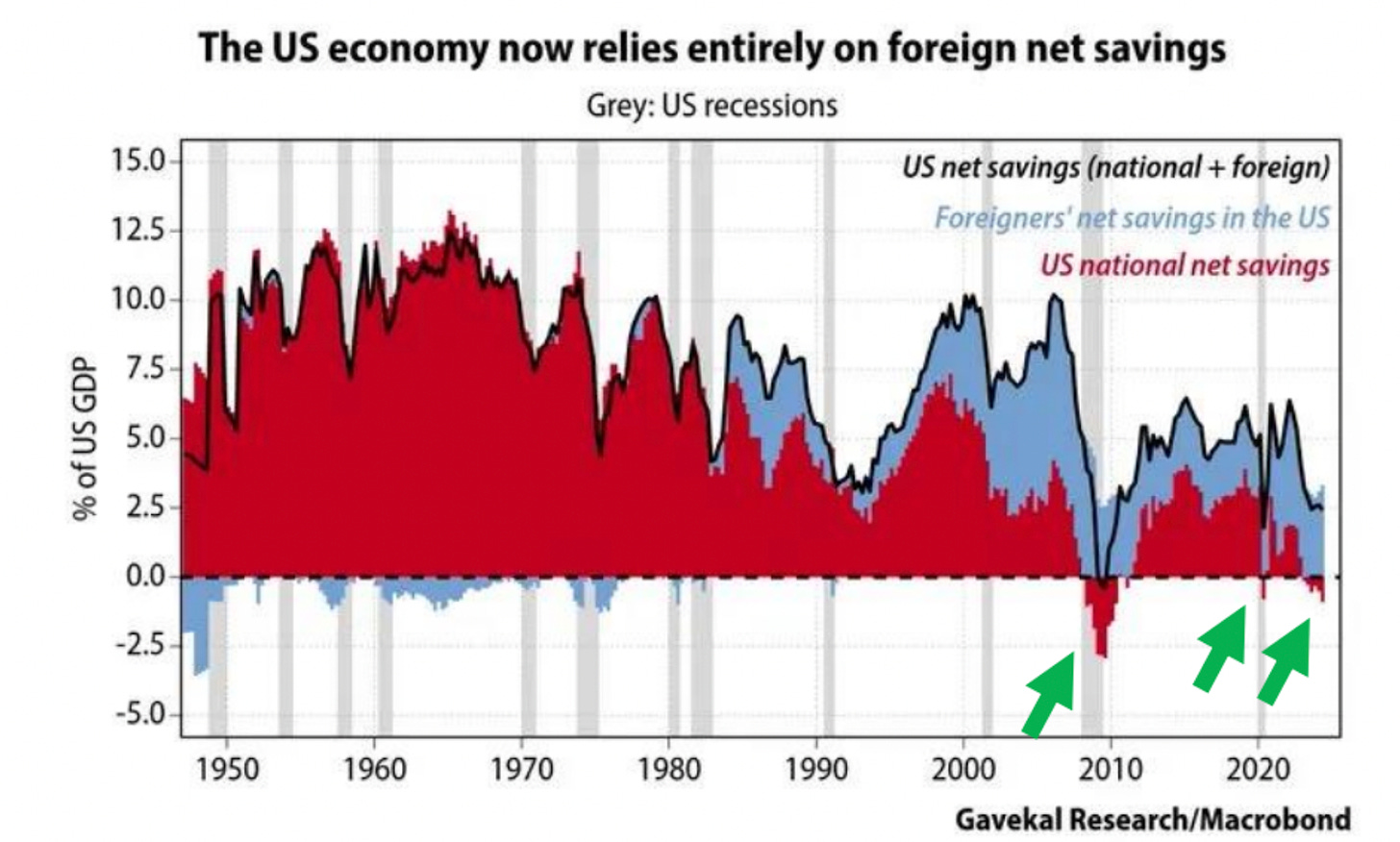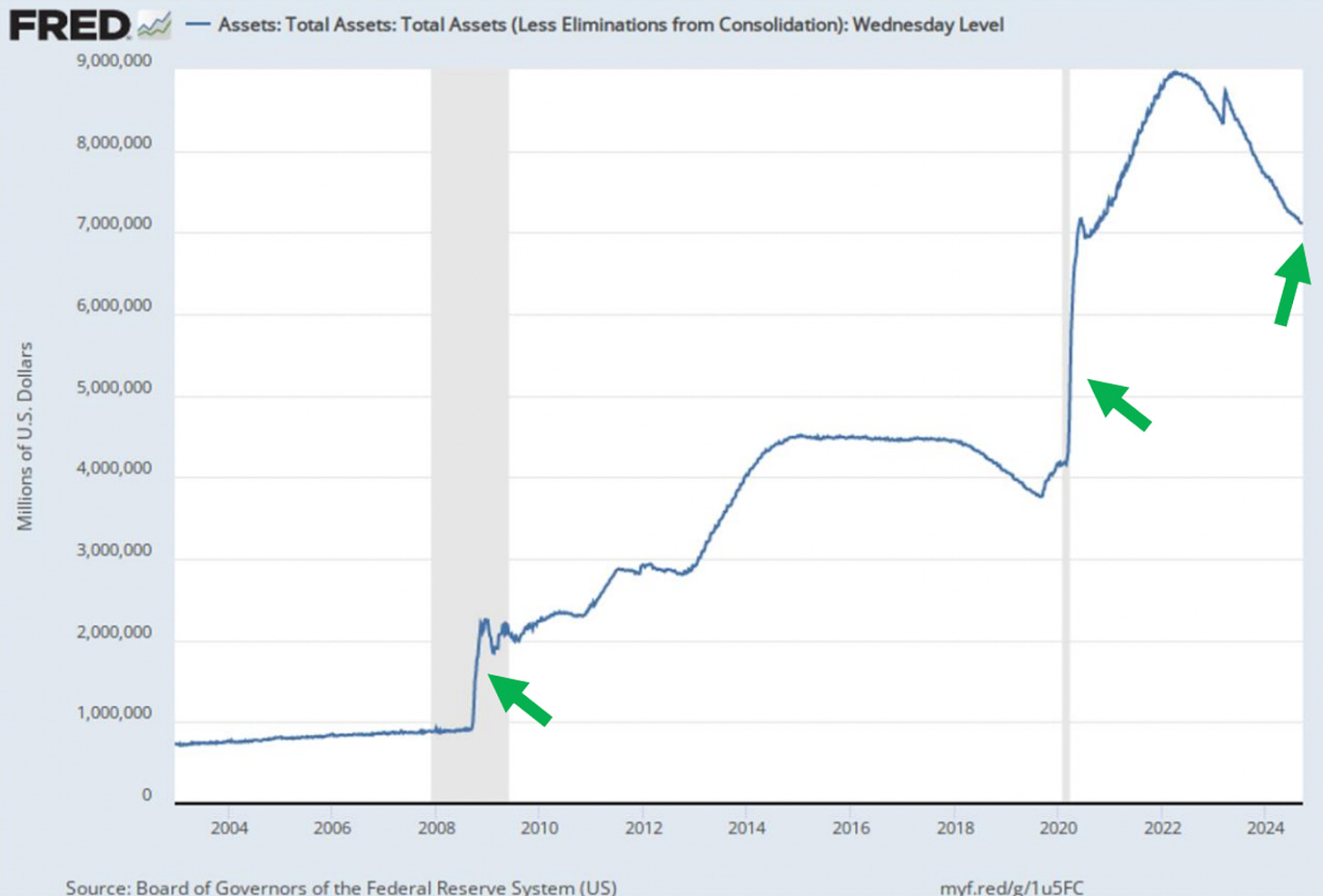原作者: アーサー・ヘイズ
原文翻訳: TechFlow
(本記事で述べられている意見は著者の個人的な意見であり、投資判断の根拠として使用されるべきではなく、また投資アドバイスと見なされるべきではありません。)
私は10月の最初の2週間をニュージーランドの南島でスキーをしました。 ガイド前のシーズンを北海道で一緒に過ごした は、ニュージーランドはバックカントリースキーには世界でも最高の場所の一つだと断言しました。私は彼を信じ、彼と一緒にワナカへ2週間出発し、パウダースノーと素晴らしいスキーラインを追い求めました。天気にも恵まれ、私はいくつかの素晴らしい山頂を滑り降り、巨大な氷河を横切りました。さらに、アルパインクライミングの知識も深めました。
南島の嵐は極めて激しい。天気が悪いときは、家か山小屋に留まる。ある日、時間をつぶすためにガイドが雪崩科学の講座を開いた。私は十代の頃、ブリティッシュコロンビアで初めて荒野を冒険して以来、何度も雪崩の訓練をしてきたが、正式な認定講座を受けたことはなかった。
この知識は、興味深くもあり、また冷静に考えさせられるものでもあります。なぜなら、学べば学ぶほど、雪崩地帯でスキーをするときには常に危険が伴うことに気づくからです。したがって、目標は、リスクを許容範囲内に抑えることです。
このコースでは、さまざまな種類の雪層と、それがどのようにして雪崩を引き起こすのかを取り上げます。最も危険なものの 1 つは持続性弱層 (PWL) で、これがストレスを受けると持続性スラブ雪崩を引き起こす可能性があります。
雪崩科学では、持続的弱層 (PWL) とは、長期間にわたって構造的に弱いままの雪の特定の層を指し、雪崩の危険性を大幅に高めます。これらの層は雪の中に深く埋もれ、スキーヤーの通過や新たな降雪などの追加のストレスによって誘発されるまで、長期間にわたって不安定なままであるため、特に危険です。PWL の存在を知ることは、雪崩を予測する上で非常に重要です。なぜなら、PWL は、大規模で深く、致命的な雪崩の原因となることが多いからです。
第二次世界大戦後の中東の地政学的状況は、現代の世界秩序におけるPWLの層のようなもので、その引き金は通常イスラエルに関連しています。金融市場の観点から私たちが懸念している雪崩には、エネルギー価格の変動、世界のサプライチェーンへの影響、そしてイスラエルと他の中東諸国(特にイランまたはその代理国)との敵対関係が激化した場合の核兵器使用につながるかどうかが含まれます。
投資家やトレーダーとして、私たちは危険で刺激的な状況にあります。一方では、中国がすでに大規模な紙幣増刷によるリフレ政策に乗り出しているように、主要経済国は通貨の価格を下げ、通貨供給量を増やしています。今こそ最大の長期リスクを取るべき時であり、もちろん、暗号通貨のリスクです。しかし、イスラエルとイランの緊張が高まり続け、ペルシャ湾の油田が破壊され、ホルムズ海峡が封鎖され、核兵器が爆発した場合、暗号通貨市場は打撃を受ける可能性があります。よく言われるように、戦争に投資することはできません。
私は選択を迫られています。法定通貨を売り続けて仮想通貨を買うか、仮想通貨の保有を減らして現金か米国債に移すか。これが本当に仮想通貨の新たな強気相場の始まりなら、私はチャンスを逃したくありません。しかし、イスラエルとイランが引き起こした金融市場の大暴落でビットコインが1日で50%も急落したときに、大金を失いたくもありません。ビットコインは必ず回復しますが、ポートフォリオにある価値のないもの、たとえばミームコインの方が心配です。
Maelstrom ポートフォリオの構成方法を検討する際の私の考えを理解していただくために、簡単なシナリオ分析を読者に説明したいと思います。
シナリオ分析
シナリオ 1: イスラエルとイランの紛争は小規模な軍事衝突に発展します。イスラエルは暗殺作戦を継続し、イランは予測可能な、脅威のないミサイル攻撃を数回行います。重要なインフラは破壊されず、核攻撃も行われません。
シナリオ 2: イスラエルとイランの紛争が激化し、中東の石油インフラの一部または全部が破壊され、ホルムズ海峡が閉鎖され、さらには核攻撃が行われる。
シナリオ 1 では、持続的な弱い層は安定していますが、シナリオ 2 ではそれが失敗し、金融市場の暴落につながります。2 番目のシナリオは私のポートフォリオに脅威をもたらすため、これに焦点を当てています。
2 番目のシナリオが暗号資産市場、特に暗号資産の中でも準備資産であるビットコインに与える影響を評価し、暗号資産市場全体がそれに応じて変動することになります。
私がもっと心配しているのは、米国がTHAADミサイル防衛システムのイスラエル配備を約束した今、イスラエルが攻勢を強めるかもしれないということだ。イスラエルは大規模な攻撃を計画している可能性があり、イランからの強力な反撃を予想している。そのため、バイデン米大統領に増援を要請している。また、イスラエルがイランの石油施設や核施設を攻撃しないと公言すればするほど、それが彼らの真意なのかどうか疑わしくなってくる。
米国は日曜日、米軍と最新鋭のミサイル防衛システムをイスラエルに派遣すると発表した。これはイランのミサイル攻撃を受けてイスラエルの防空力を強化することを目的とした非常に珍しい派遣である。 ロイター通信が報じた。 .
リスク1: ビットコインマイニングマシンの物理的破壊
戦争は極めて破壊的です。ビットコインのマイニングマシンは、暗号通貨の最も価値があり重要な物理的資産です。戦争が勃発したら、どのような被害を受けるのでしょうか?
この分析の主な前提は、紛争がどの地域に広がるかである。イスラエルとイランの戦争は米国/EUと中国/ロシアの代理戦争に過ぎないが、どちらの側も直接戦うことを望んでいないと私は推測する。紛争を中東のこれらの国に限定する方が望ましい。さらに、最終的な交戦国はすべて核保有国である。世界で最も攻撃的な軍事大国である米国は、他の核保有国を直接攻撃したことはない。米国は核兵器を使用した唯一の国であるため(第二次世界大戦を終わらせるために核爆発を使用して日本を降伏させたとき)、これは何かを物語っている。したがって、実際の軍事紛争は中東に限定されると想定するのは合理的である。
次の質問は、中東でビットコインのマイニングを盛んに行っている国はあるかということです。 一部のメディアの報道によると イランはビットコイン採掘が急成長している唯一の国です。さまざまな情報源によると、イランのビットコイン採掘者は世界の計算能力の 7% を占めています。イランの計算能力が国内のエネルギー不足や施設へのミサイル攻撃により 0% に低下した場合、どのような影響があるでしょうか。基本的に何もありません。
これは、2021 年 1 月から 2022 年 3 月までのビットコイン ネットワーク ハッシュレートのグラフです。
2021年半ばに中国がビットコインのマイニングを禁止したとき、ハッシュレートが63%も急落したのを覚えていますか?ハッシュレートはわずか8か月で2021年5月の最高値まで回復しました。マイナーが中国から移転したか、他の国のプレイヤーが経済状況の好転によりハッシュレートを上げました。それに加えて、ビットコインは2021年11月に史上最高値を更新しました。ネットワークハッシュレートの大幅な低下は、価格に目立った影響を与えません。したがって、たとえイランがイスラエルや米国によって完全に破壊され、世界のハッシュレートが最大7%も減少したとしても、ビットコインには影響はありません。
リスク2: エネルギー価格の急騰
次に、イランが報復として主要な油田とガス田を破壊したらどうなるか考えてみましょう。西側諸国の金融システムの弱点は安価な炭化水素の不足です。たとえイランがイスラエルを破壊できたとしても、戦争を防ぐことはできません。イスラエルは米国の覇権体制にとって、有用で使い捨ての付属物にすぎません。イランが西側諸国を攻撃したいのであれば、炭化水素の生産を破壊し、タンカーがホルムズ海峡を通航するのを阻止しなければなりません。
石油価格が高騰し、石油不足の国々が経済維持のために他のエネルギーに目を向けるにつれて、他のすべてのエネルギー価格も上昇するでしょう。では、ビットコインの法定通貨価格はどうなるでしょうか? ビットコインとともに上昇するでしょう。
ビットコインは、デジタル形式で保存されたエネルギーと考えることができます。したがって、エネルギー価格が上昇すると、ビットコインの法定通貨価値も上昇します。すべてのマイナーがエネルギー価格の同時上昇に直面するため、ビットコインマイニングの収益性は変わりません。一部の大規模な産業マイナーにとっては、政府が電力会社に不可抗力条項を発動して契約を解除することを要求しているため、エネルギーの入手が困難になる可能性があります。しかし、コンピューティングパワーが低下すれば、マイニングの難易度も低下するため、新規参入者はエネルギー価格が上昇しても収益を上げることができます。サトシ・ナカモトが設計したこのメカニズムの優雅さが十分に実証されるでしょう。
エネルギーショックに対する外貨の耐性を示す歴史的例が欲しければ、1973年から1982年にかけての金の取引を見ればよい。1973年10月、アラブ諸国は、ヨム・キプール戦争における米国のイスラエル支援への報復として、米国に対して石油禁輸措置を課した。1979年には、西側諸国の支援を受けた国王を打倒し、現在の神政政治体制を確立した革命により、イランの石油供給は世界市場から撤退した。
スポット原油価格(白)と金価格(黄色)が、米ドルを100とする基準に対してプロットされています。原油価格は412%上昇し、金価格もほぼ追いつき、380%上昇しました。
これは、SP 500(赤)と比較した金(ゴールド)の価格を、ベースを100として石油価格で割ったものです。金の購買力はわずか7%しか失われていませんが、株式は80%を失っています。
どちらかが中東の炭化水素を市場から排除したと仮定すると、ビットコインのブロックチェーンは機能し続け、その価格は少なくともエネルギーに対する相対的な価値を維持し、法定通貨の観点からは確実に上昇するだろう。
物理的リスクとエネルギーリスクについて説明しましたが、最後に通貨リスクについて検討してみましょう。
リスク3: 通貨
重要な問題は、米国がこの紛争にどう対応するかだ。民主党も共和党もイスラエルを断固支持している。イスラエル軍がイランとその代理勢力を破壊しようとする過程で、無実の民間人が犠牲になったとしても、米国の政治エリートたちはイスラエルを支持し続けるだろう。米国は武器を提供することでイスラエルを支援している。イスラエルはイランとその代理勢力と戦うために必要な武器を買うことができないため、米国政府は借金をしてロッキード・マーティンなどの米国の武器商人に支払い、イスラエルに弾薬を供給している。2023年10月7日以来、イスラエルは$179億の軍事援助を受けている。
米国政府は貯蓄ではなく、借り入れによって購入を行っています。上のグラフが示しているのは、このことです。イスラエルに無償の武器を提供するために、多額の負債を抱える米国政府はさらに借り入れる必要があります。問題は、国民貯蓄がマイナスになったときに誰がこの負債を買うのかということです。グラフの緑の矢印は、米国の国民純貯蓄がマイナスだった期間を示しています。 ルーク・グローメン これらの矢印は連邦準備制度のバランスシートの急激な拡大に対応していると指摘しています。
イスラエルを支援する軍事作戦で軍閥の役割を担う米国は、さらなる借り入れが必要になるだろう。2008年の世界的金融危機やCOVID-19によるロックダウンの余波と同様に、連邦準備制度理事会や商業銀行システムのバランスシートは、追加債務の発行を吸収するために劇的に拡大するだろう。
連邦準備制度理事会のバランスシートが再び大幅に拡大した場合、ビットコインはどのように反応するでしょうか?
これはビットコインの価格をFRBのバランスシートで割ったもので、値は100です。ビットコインは登場以来、FRBのバランスシートの成長を25,000%上回っています。
戦争はインフレを引き起こすことはわかっています。米国政府がイスラエルに武器を売るために借金をする必要があることもわかっています。また、連邦準備制度理事会と米国の商業銀行システムが紙幣を印刷し、バランスシートを拡大することでこの負債を買い取ることもわかっています。したがって、戦争が激化するにつれて、ビットコインの法定通貨価格が大幅に上昇することが予測されます。
イランの軍事費について、中国とロシアは何らかの形でイランの戦争努力を支援するのでしょうか?中国はイランの炭化水素を購入する用意があり、中国とロシアもイランに商品を販売していますが、これらの取引は信用取引ではありません。より現実的な観点から言えば、中国とロシアはおそらく戦後の役割を担うことになると思います。彼らは公には戦争を非難しますが、イランの破壊を防ぐための効果的な措置を実際に講じることはないと思います。
イスラエルは国家建設には興味がない。むしろ、攻撃がイランの民衆の不安による政権崩壊の引き金になることを期待しているのかもしれない。そうなれば、特に中国は、いつもの外交戦術を使って、弱体化したイラン政府に融資し、中国の国有企業を使って国を再建するのを手伝うことができる。これは事実上、習近平中国国家主席が在任中に推進してきた一帯一路構想である。鉱物資源や炭化水素資源が豊富なイランは、中国の経済圏に完全に組み入れられるだろう。中国は、過剰生産している高品質で低価格の工業製品を廃棄するための新たな市場を南半球に見つけることができるかもしれない。その見返りとして、イランは中国に安価なエネルギーと工業原料を提供するだろう。
このように考えると、中国とロシアの支援によって世界の法定通貨の供給量は増加しないため、ビットコインの法定通貨価格に目立った影響は与えないだろう。
中東紛争の激化によって、暗号通貨を支える重要な物理的インフラが破壊されることはない。エネルギー価格が高騰するにつれ、ビットコインと暗号通貨の価値は上昇するだろう。新たに発行される数千億、あるいは数兆ドルが、ビットコイン市場の強気相場を再び牽引するだろう。
慎重に取引する
ビットコインは長期的には上昇する可能性がありますが、これは価格が激しく変動しないことを意味するものではなく、すべてのアルトコインが同様に利益を得ることを意味するものでもありません。重要なのは、投資規模を適切に制御することです。
私は、自分が所有するすべての投資について、市場価値の激しい変動を覚悟しています。読者の中にはご存知の方もいると思いますが、私はいくつかのミームコインに投資しています。イランがイスラエルにミサイルを発射したとき、私はそれらの投資を断固として削減しました。なぜなら、短期的に紛争の激化に暗号資産がどのように反応するかを予測するのは難しいからです。私は、ジョークの暗号資産で全資本を失ったら非常に動揺するだろうと考え、過剰投資していることに気づきました。現在、私が所有しているミームコインは、Church of Smoking Chicken Fish (ティッカー: SCF) だけです。ラーメン。
私は、Maelstrom の投資責任者である Akshat に、プレセール トークンへの投資を減速または停止するように依頼していません。Maelstrom が保有する遊休資金については、さまざまな流動性の高いアルトコインに参入する適切な時期を待ちながら、適切な利回りを得るために Ethena にステークする予定です。
トレーダーとしてできる最悪のことは、戦争で誰が正しい側にいるかに基づいて取引を行うことです。このアプローチは、戦争の両側が財政的抑圧、資産の没収、破壊に直面することになるため、失敗につながります。最も賢明なことは、まず自分自身と家族の安全を確保し、次に不換紙幣の価値下落に耐え、エネルギーの購買力を維持できる投資手段に資本を投入することです。
この記事はインターネットから引用したものです: アーサー・ヘイズ氏の新しい記事: 中東紛争の激化とエネルギー価格の上昇により、長期的にはビットコインの価値が上昇する
関連: GoPlus Research: Eigenlayer の詳細、AVS の設計と構築
原作者:GoPlus 背景 昨年から今日まで、EigenLayerはイーサリアムエコシステムの中核を成す存在として、$100億以上のTVLを蓄積してきました。しかし、EigenLayerの最も有名な特徴は再ステーキングのコンセプトであるため、ほとんどの人はそれを単に金融インフラと見なすかもしれません。この第一印象から、EigenLayerはユーザーが追加のステーキング収入を得るのを助けるプラットフォームに過ぎないと人々は考えがちです。実際、深く考えてみると、重要な疑問が浮かび上がります。再ステーキングされたETHまたはLST(流動性ステーキングトークン)がなぜ追加収入を生み出すことができるのか?この疑問に対する答えは、EigenLayerの本質を明らかにします。EigenLayerは実際には革新的な金融主導のクラウドコンピューティングインフラストラクチャだと思います。この定義は一見矛盾しているように聞こえるかもしれませんが、まさにEigenLayerの革新性を反映しています。














